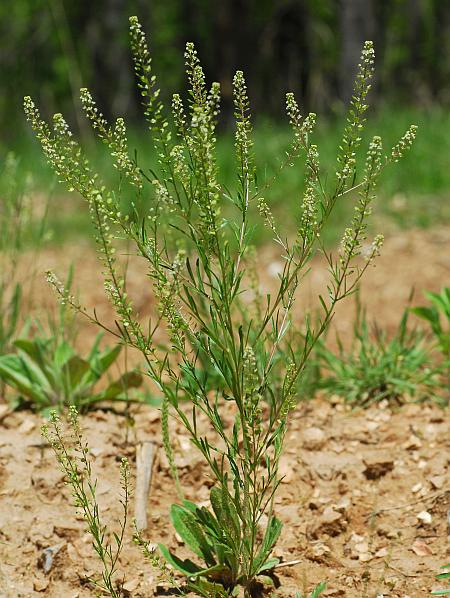Lepidium virginicum L.
Poor Man's Pepper Grass

Native
CC = 0
CW = 3
MOC = 83
© DETenaglia
Lepidium virginicum L.Poor Man's Pepper Grass | |
 |
Native CC = 0 CW = 3 MOC = 83 |
© DETenaglia |
|
Family - Brassicaceae Habit - Taprooted annual or biennial forb. Stems - Ascending to erect, to 60 cm, typically single from the base, often branching in upper 1/3, pubescent especially in the upper parts with minute, curved, mostly ascending hairs with pointed tips (visible with magnification).
Leaves - Alternate, the basal leaves typically wilted by anthesis, 2.5-10.0 cm long, linear to oblanceolate or elliptic to obovate in outline, the bases not clasping, glabrous or less commonly minutely hairy on the undersurface, the lower and basal leaves often 1 time pinnately lobed, the margins entire to coarsely toothed, petiolate, the upper leaves reduced, linear, sessile or nearly so, the margins usually entire.
Inflorescence - Terminal and lateral racemes, compact in flower, quickly elongating in fruit. Pedicels 2-4 mm long in flower to 5 mm in fruit, spreading. Bracts absent.
Flowers - Sepals 4, 0.7-1.0 mm long, linear to narrowly elliptic. Petals 4, 1.5-2.5 mm long, white. Stamens 2. Filaments white, glabrous, to 1 mm long. Anthers yellow. Styles 0.1-0.2 mm long.
Fruits - Silicles 2-4 mm long, circular, widest at the middle, the tip shallowly notched and sometimes narrowly winged, flattened, glabrous. Seeds 1.1-1.7 mm long, narrowly obovate to elliptic in outline, usually winged around most of the margin or at least at the tip, the surface minutely roughened, light orange.
Flowering - April - November. Habitat - Glades, tops of bluffs, prairies, and rocky openings of dry upland forests, pastures, fields, railroads, roadsides, and open, disturbed areas. Origin - Native to the U.S. Lookalikes - L. densiflorum, L. campestre. Other info. - This species can be found throughout Missouri and the eastern half of the continental U.S. It is recognized by its cylindrical inflorescences of small white flowers, round fruits with notched apices, and nearly glabrous leaves. Differentiation of this species from L. densiflorum can be difficult and rests on morphological subtleties. Relative to that species, L. virginicum has curved (not straight) hairs on the inflorescence axis; fruits which are nearly round; and petals which are normally longer than the sepals. The plant also somewhat resembles L. campestre, but that species is densely hairy all over. Photographs taken in Brown Summit, NC., 5-18-02 (DETenaglia); also at Matson Hill County Park, St. Charles County, MO, 4-30-2015 (SRTurner). |